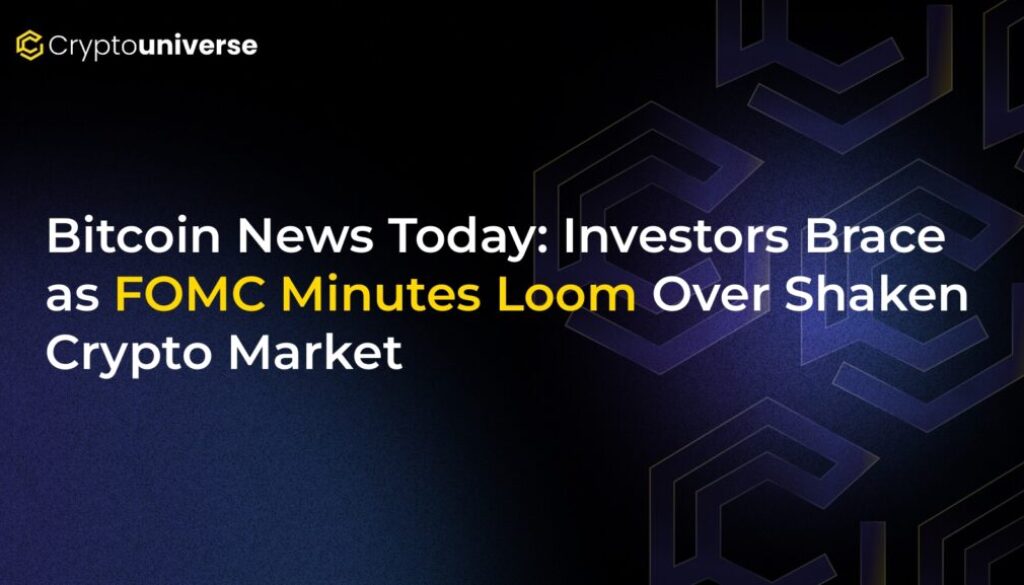Bitcoin News Today: Investors Brace as FOMC Minutes Loom Over Shaken Crypto Market

Crypto Market Sees Red as Federal Reserve Anxiety Mounts
The cryptocurrency market is on edge, with Bitcoin (BTC) and Ether (ETH) retreating from recent highs as investors anxiously await the release of the U.S. Federal Reserve’s July FOMC meeting minutes. A wave of risk-off sentiment has swept across digital assets, triggering a massive liquidation event and sending ripples of uncertainty through the market.
In a dramatic turn, over $500 million in leveraged long positions were forcibly liquidated, a clear sign that traders betting on continued price increases were caught off guard. Bitcoin positions accounted for $124 million of the total, while Ether traders lost $184 million. This sharp correction saw Bitcoin, which briefly touched $124,496 last week, fall to a low of $114,706. Ether also felt the pressure, declining 2.5% to $4,354, pulling back from its recent approach to the $4,800 all-time high.
A Perfect Storm: Macroeconomic Headwinds Batter Crypto
The current volatility isn’t just about the Fed. A confluence of macroeconomic and geopolitical factors is creating a challenging environment for risk assets like cryptocurrencies. Investors are grappling with several key pressures:
- Trade Tensions and Inflation: The U.S. government’s recent decision to impose a 50% import tariff on certain aluminum and steel products has stoked fears of supply chain disruptions and renewed inflationary pressures, souring investor mood.
- Regulatory Scrutiny: Uncertainty on the regulatory front continues to weigh on the market. Recent reports that the U.S. Securities and Exchange Commission (SEC) is investigating Alt5 Sigma, a firm linked to a company co-founded by Donald Trump, have added to the cautious sentiment.
- Global Financial Jitters: In a significant development, Japan’s 10-year government bond yield surged to its highest level since 2008, climbing above 1.61%. This signals growing fiscal concerns in one of the world’s largest economies, which could tighten global financial conditions and pull capital away from assets like Bitcoin.
Contrasting Signals: Extreme Fear in Options vs. Strong Institutional Buying
While the immediate price action looks bearish, a deeper look at market data reveals a more complex picture. On one hand, the Bitcoin options market is flashing signs of extreme fear. The 30-day delta skew, which measures the demand for bearish puts versus bullish calls, has spiked to 12%. Under normal conditions, this metric hovers between -6% and +6%, making the current reading a clear indicator of heightened anxiety.
However, history suggests this may not be a long-term death knell for the bull market. Similar spikes in fear, such as the 13% level seen in April, were followed by significant price rebounds, with some traders seeing gains of up to 40% in the subsequent month.
Contrasting this fear is the unwavering flow of institutional capital. Despite the market turbulence, cryptocurrency ETFs posted massive weekly inflows. Ether-based funds led the charge, attracting a record $2.9 billion in a single week—their 14th consecutive week of positive flows. Bitcoin ETFs also saw a healthy $547 million in weekly inflows. This resilience suggests that large-scale, long-term investors may be using this price dip as a buying opportunity, undeterred by short-term volatility.
What’s Next? All Eyes on the Fed’s Jackson Hole Symposium
The entire financial world is now focused on the Federal Reserve. The upcoming release of the FOMC minutes is the most immediate catalyst, as it could provide crucial insights into the central bank’s thinking on future rate cuts. A hawkish or uncertain tone could easily reignite risk-off behavior, potentially pushing crypto and equity markets lower.
Following the minutes, investors will turn their attention to the Fed’s annual Jackson Hole symposium and the latest jobless claims data. These events will offer further clues about the health of the economy and the Fed’s policy path. For now, the crypto market remains in a precarious position, caught between macroeconomic fears and strong institutional conviction, as investors brace for what the Fed will say next. The release of the


